“For almost a generation there was no more secluded or more beautiful section than the vicinity of “Fox Corners.”—New York Daily Tribune, February 28, 1909
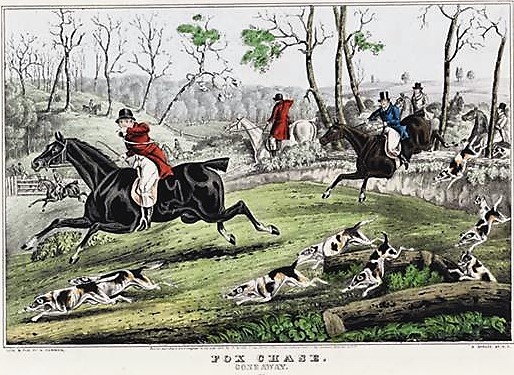
American Loyalists and British soldiers took part in many fox hunts throughout the southeastern Bronx during colonial days. The hunts originated at Fox’s Corners between present-day Southern Boulevard, West Farms Road, and Westchester Avenue (the British often joked about running the foxes and chasing the Americans.) This area was later called Foxhurst for the Fox and Tiffany family estate constructed at Fox’s Corners.
In my last post, I wrote about Swain’s performing rats and cats, which once appeared at the old Loew’s Boulevard Theatre near Fox’s Corners on Southern Boulevard in the Bronx. The theater was constructed in 1912-13 on what had formerly been the country estate and cattle farm of Richard March Hoe, the inventor of the rotary press (aka lightning press). Just a few blocks northeast of Hoe’s estate, which he called Brightside, was the estate of William Woolley Fox, which he called Foxhurst (aka Fox Hurst).
It was in this section of the Bronx that Brigadier-General Oliver De Lancey (or Delancey) and his fellow Loyalists (aka Tories) from Westchester and Queens counties took part in fox hunts during the Revolutionary era in the late 1700s. These hunts always commenced at the Fox Farm House (aka Hunt Inn or Fox’s Corners Inn), a rendezvous for British and Loyalist officers and fox hunters at the junction of West Farms Road and Westchester Turnpike (today’s Westchester Avenue).
Richard’s Hoe’s Brightside Estate
In 1859, give or take a year, Richard March Hoe purchased land for a country estate overlooking the Bronx River. Here, he erected a handsome home and raised some of the finest blooded cattle (Jersey cows) in what was then called Westchester County.
Hoe’s land was part of a much larger farm previously owned by Christopher V. Spencer, a native of Providence, Rhode Island and an active member of the Society of Friends (aka Quakers). Little is known of Christopher, except that he lived in the West Farms section of the Bronx for a while until moving to New Jersey in 1864. Spencer allegedly married two women on the same day in 1856 and he grew peaches on his land.
In 1909, only fifty years after Hoe constructed his mansion at Brightside, Randall Comfort wrote of the estate’s destruction:
When the subway came, it all changed. Perhaps in no other section of the city has such a transformation come about. This rural section of the borough was changed from woodland scenes to the modern city bustle and attendant five story apartment houses. Today there is nothing but a pile of lathes and countless bits of plaster to bear witness to the last brave battle offered by the old homestead. Railroad tracks wind, like serpents, over the once velvety lawns, and contractors’ wagons swarm like so many bees, while half a hundred stumps form a silent little group of witlessness themselves.
Judging from the speed with which they tore down the old Hoe mansion, I should not be surprised to learn that a whole block of houses, elevators and all, were ready for occupancy on the Hoe estate even before the next issue of your paper reaches the hands of its readers.
Randall Comfort wasn’t too far off: The Chester Hall apartments, which were the first buildings to feature elevators in the Fox’s Corners section of the Bronx, were constructed only about one year after the Brightside mansion came down.
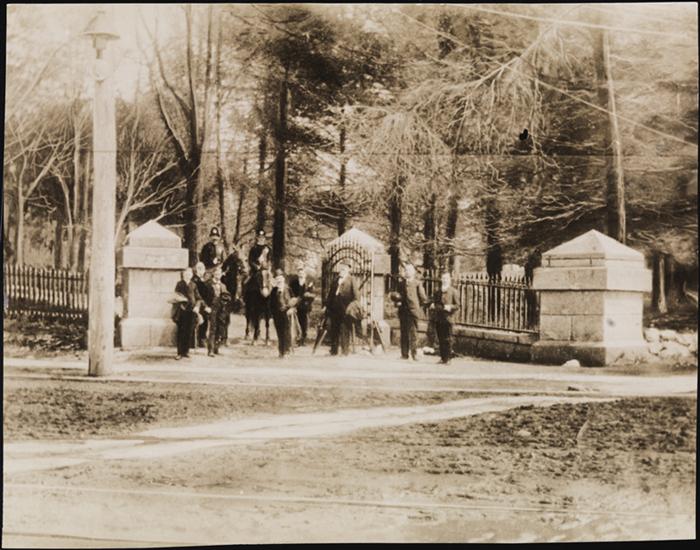
The grand entrance to Brightside–pictured here in 1905–was on Westchester Turnpike (present-day Westchester Avenue). Look closely and you can see two men–perhaps police officers–on horseback in the background.
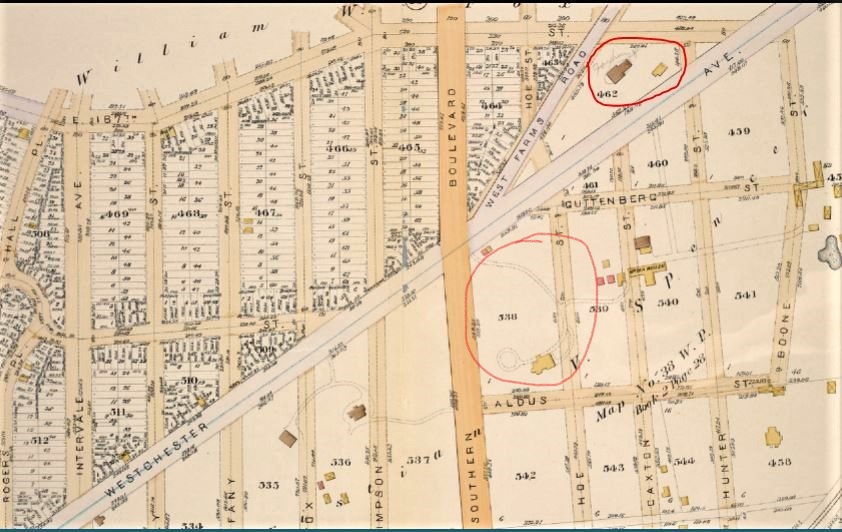
The Brightside estate (in bottom red circle) and the Foxhurst estate (top red circle) are shown on this 1887 map. The triangular lot occupied by the Foxhurst estate was called Fox’s Corners. As you can see, most of the lots during this time were either still vacant or occupied by large estates awaiting their own demise. NYPL Digital Maps
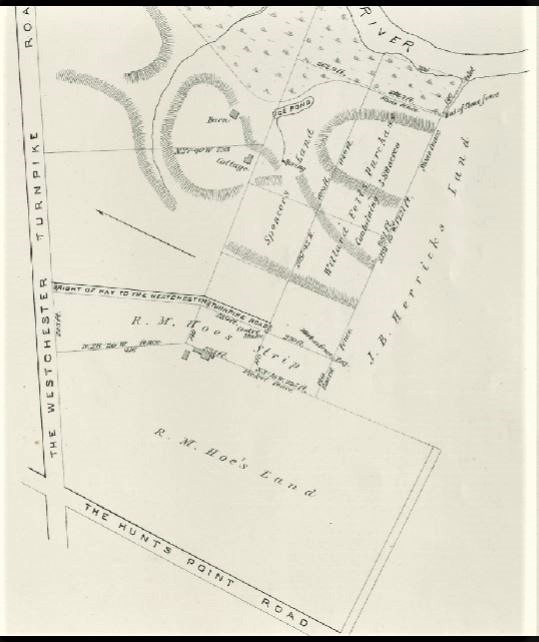
Here’s another old map (1859 map of the C.V. Spencer Farm) showing Richard Hoe’s newly purchased land. Back then, Southern Boulevard was called the Hunt Point’s Road, which is now called Hunts Point Avenue.

Richard Hoe built Brightside on the northwest corner of present-day Hoe Avenue and Aldus Street, right about where the ball courts are in this aerial view. A long driveway led to the secluded property from what was then called Westchester Turnpike. Today the property is occupied by Printer’s Park, the old Loew’s Theatre, the Chester Hall apartments (top right), and several other shops and apartments.
The Old Hunt Inn at Fox’s Corners

The old Hunt Inn, better known as the Fox Farm House or Fox’s Corners Inn, stood on the west side of West Farms Road between Hoe Avenue and Southern Boulevard near 167th Street for over 200 years, until 1892. NYPL Digital Collections
During the 18th through early 20th centuries, the junction of present-day Westchester Avenue, West Farms Road, and Southern Boulevard was known as Fox’s Corners. Although fox hunts did take place in this location, the name more likely originates from the large Fox estate–later called the Tiffany estate (yes, that Tiffany family)–which was owned by numerous generations of the Hunt, Leggett, Fox, and Tiffany families.
The Fox estate was part of a 1,000-acre parcel purchased by Edward Jessup and John Richardson from the Native Americans and confirmed by a crown patent under the reign of King James II of Great Britain in the 17th century. This land was known as the Great Planting Neck, a part of which was subsequently called Leggett’s Point (and is now called Oak Point).
John Richardson had two sons and three daughters. His daughter Elizabeth married Gabriel Leggett, who, by the right of his wife, inherited a large portion of the Great Planting Neck (Leggett’s Point).
Edward Jessup had one son and three daughters. His daughter (also named Elizabeth) married Thomas Hunt, Jr., the son of Thomas Hunt of the “Grove Farm” at Spicer’s Neck and Brockett’s Neck on the banks of Westchester Creek (later called Ferris’s Point and now known as Old Ferry Point).

Oliver De Lancey (1749-1822)
In 1666, Jessup and Richardson built what would later be called the Hunt Inn or Fox’s Corners Inn (depending on which family was residing there at the time). The stone and wood-frame house was first used as a “three-pence-beer” inn for early colonial settlers. The inn was also a rendezvous for British officers and American Loyalists.
During the Revolutionary era, Brigadier-General Oliver De Lancey, commander of the Loyalists in Westchester, and his nephew James De Lancey headed up three battalions of 500 men each known as De Lancey’s Volunteers or De Lancey’s Cowboys. Oliver De Lancey often invited his fellow officers from Queens County to participate in fox hunts with their hounds.
Although the fox chases always started at the inn, it wasn’t until later years that the locality became known as “Fox’s Corners.” (Actually, it was quite coincidental that the Fox and Hunt families owned the property where the fox hunts took place.)
The descendants of Elizabeth and Thomas Hunt stopped operating the inn in 1700, but they continued to live in the building until 1816, when the property was purchased by the descendants of Elizabeth and Gabriel Leggett. In the mid-1800s the old inn descended by marriage to the Fox family and then finally through marriage again to the Tiffanys.
When Mary Tiffany Tucker, the last Tiffany to own Fox’s Corners Inn, passed away around 1887, her baby daughter inherited the building. The last family to live in the old inn were the Langdons, who rented it from the Tiffanys until 1890.
From 1890 to 1892, the building stood vacant. Homeless men used it for lodging purposes and local boys often played inside the empty rooms. On Easter Sunday of 1892, the Tiffany’s coachman saw flames coming from the building. Some boys had been seen at the place earlier in the day, so it was thought they may have started the fire.
It was difficult for the firemen to extinguish the flames, as they had to stretch their hoses more than 500 feet across the meadows and over fences. Only one item was reportedly salvaged: a pane of glass bearing the word “Love” and a heart scratched on its surface enclosing the names of Joseph Rodman Drake and Nancy Leggett.
The Foxhurst Mansion
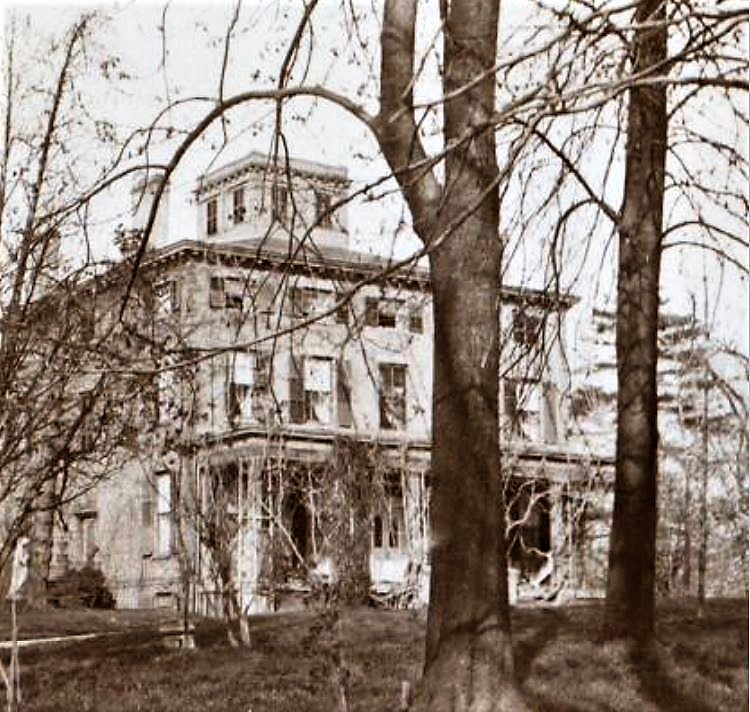
The Foxhurst Mansion was constructed around 1840. Many members of the Tiffany family, including Henry Dyer Tiffany, were born in the home, which stood on the triangular lot bounded by Westchester Avenue, West Farms Road, and East 167th Street until the early 1900s.
The Fox family name in the Bronx goes back to about 1672, which is when George Fox (1624-1691), the founder of the Society of Friends (commonly known as the Quakers), began preaching in this area. One of George’s many descendants who stayed in the area was William Woolley Fox (1783-1861).
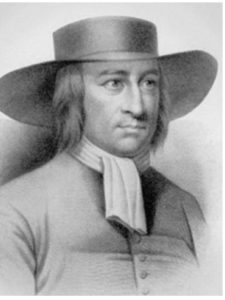
George Fox was the founder of the Quakers.
William Fox was a pioneer with the New York Gas Light Company (his brother-in-law, Samuel Leggett, was the first person in New York City to introduce gas lighting into his own house at 3 Cherry Street) and one of the five original commissioners appointed by Governor William Learned Marcy in 1833 to head up the Croton Aqueduct project that brought a fresh supply of water to the city.
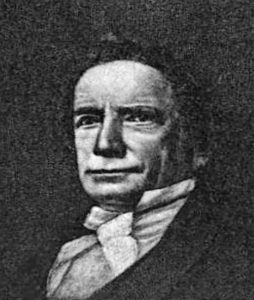
William Woolley Fox
In 1808, William Fox married Charlotte Leggett, the daughter of Thomas and Mary Haight Leggett, and a descendant (five generations removed) of Elizabeth Richardson and Gabriel Leggett. Sometime around 1840, the couple built a large home on the property that Charlotte had inherited (Lot No. 11 of the original West Farms patent). The lot reportedly contained some type of orchard before the home was constructed.
A barn, later called the Fox Barn, was constructed at the intersection of present-day 167th and 169th Streets. (The stones used to construct the barn reportedly came from the House of Refuse in Manhattan, of which Fox was a founder and governor.)
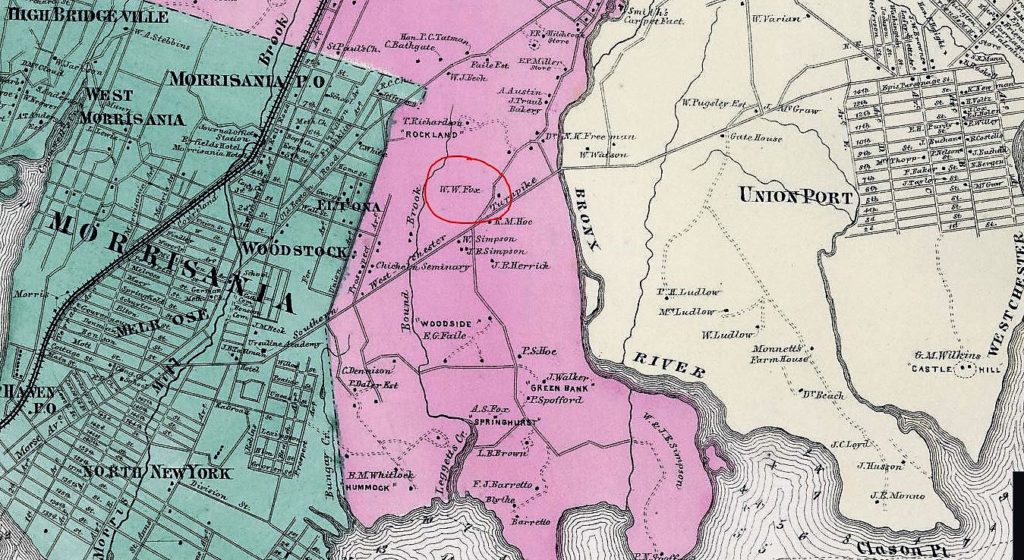
William W. Fox’s property on the north side of the Westchester Turnpike is circled in red on this 1867 map. Richard Hoe’s property is noted just south of the turnpike.
William and Charlotte had two sons and one daughter. In 1836, their daughter, Mary Lydia Fox, married Francis Alfonso Tiffany, the son of Lyman Tiffany, who was a wealthy Boston merchant. Mary and Francis had eight children, including Henry Dyer Tiffany, who was the first of the Tiffany children born in the Foxhurst mansion (December 13, 1841). By 1850, according to the census report, 12 members of the Fox and Tiffany families and 7 servants were living in the large home.
Henry lived in the Foxhurst home for most of life, where he spent much of his time engaging in speculative real estate and managing the family’s vast estate. Sometime around September 1905, Henry and his wife moved to another Tiffany home — also called Foxhurst — in Port Chester, NY. Henry died in this home in 1917.
The End of Foxhurst
In 1884, an auction took place in which portions of the old Fox estate comprising 200 lots on 165th, 167th, and 169th Streets, Stebbins Boulevard, and Westchester Avenues were sold. The auction did not directly affect Foxhurst, but by the start of the 20th century, with the opening of the new subway along Westchester Avenue, the old mansion’s days were numbered. In fact, most of the property was purchased by Henry Morgenthau during the development boom of 1905 that took place along the subway’s new route (Morgenthau was one of the largest holders of Bronx property at this time).

Here’s a photo of the front of Foxhurst from a news article printed in 1906, which is a year after the Tiffany family had moved out of the large home.
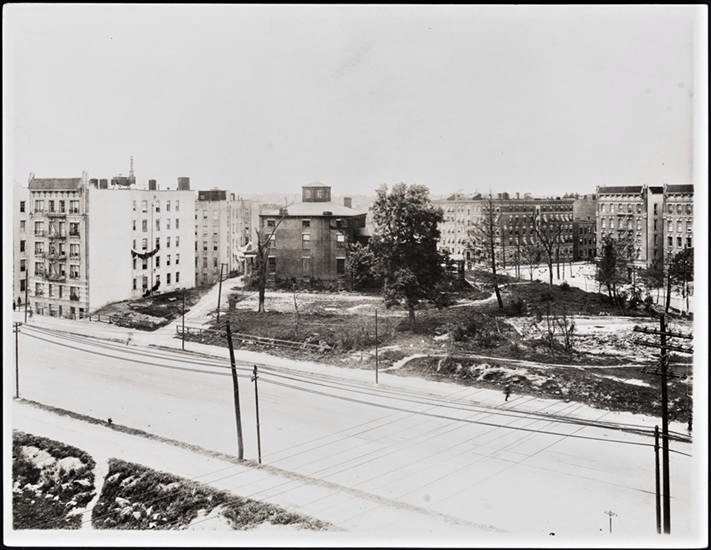
By 1913, when this photo was taken from the Westchester Avenue side, numerous lots on the old Fox estate had already been sold and developed, leaving the once grand mansion hanging on for dear life amid large tenement apartments. Museum of the City of New York Collections
In 1912, the Episcopal Mission of the Holy Spirit leased Foxhurst for use as a meeting place (the Tiffanys were members of the Episcopal church). A year later, the New York Diocesan Missionary and Church Extension Society of the Protestant Episcopal Church bought what was then being called the old Tiffany mansion for $85,000. The sale included the mansion and 16 city lots on the triangular lot.
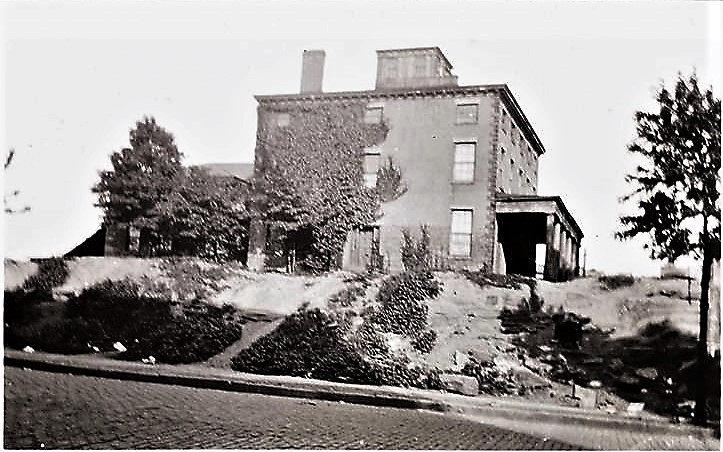
Here’s a side view of Foxhurst photographed from West Farms Road in 1913, when the home was occupied by the Episcopal Church. Museum of the City of New York Collections
I’m not sure when the old house was demolished, but it had to be sometime between 1914 and 1920. In July 1914, the Women’s Suffrage Party of the Bronx held a lawn party at Foxhurst. The women charged a nickel for those who wanted to dance inside the house, and a nickel for those who wanted to sit on the veranda. Admission to the lawn–as well as access to the mosquitoes–was reportedly free.
The next time the mansion was mentioned in the press — in 1920 — it was referred to in the past tense.
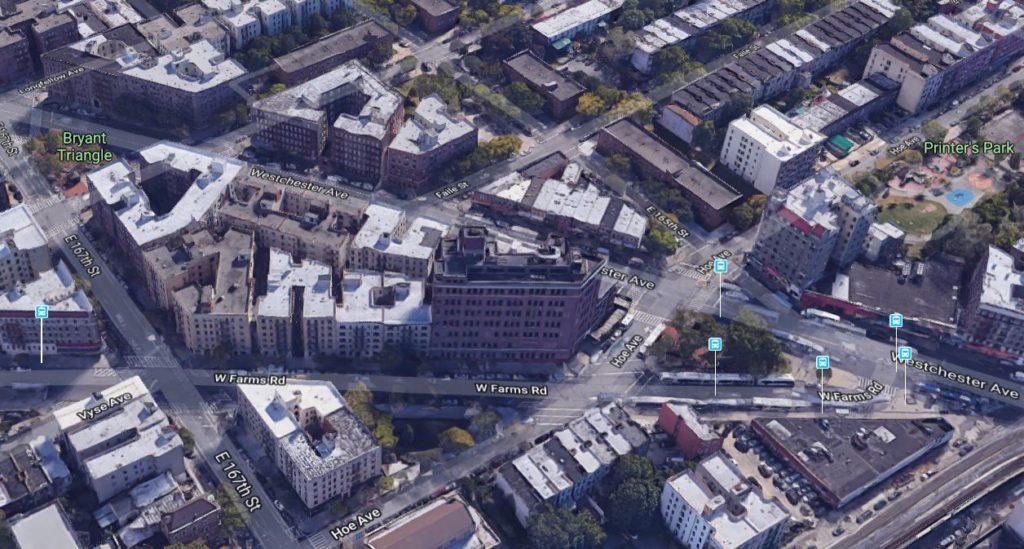
Here’s an aerial view of the former Foxhurst estate property. The little triangular park on the right–called Benjamin Gladstone Square–was originally named Fox Square in 1903 in recognition of the many services of William W. Fox.


